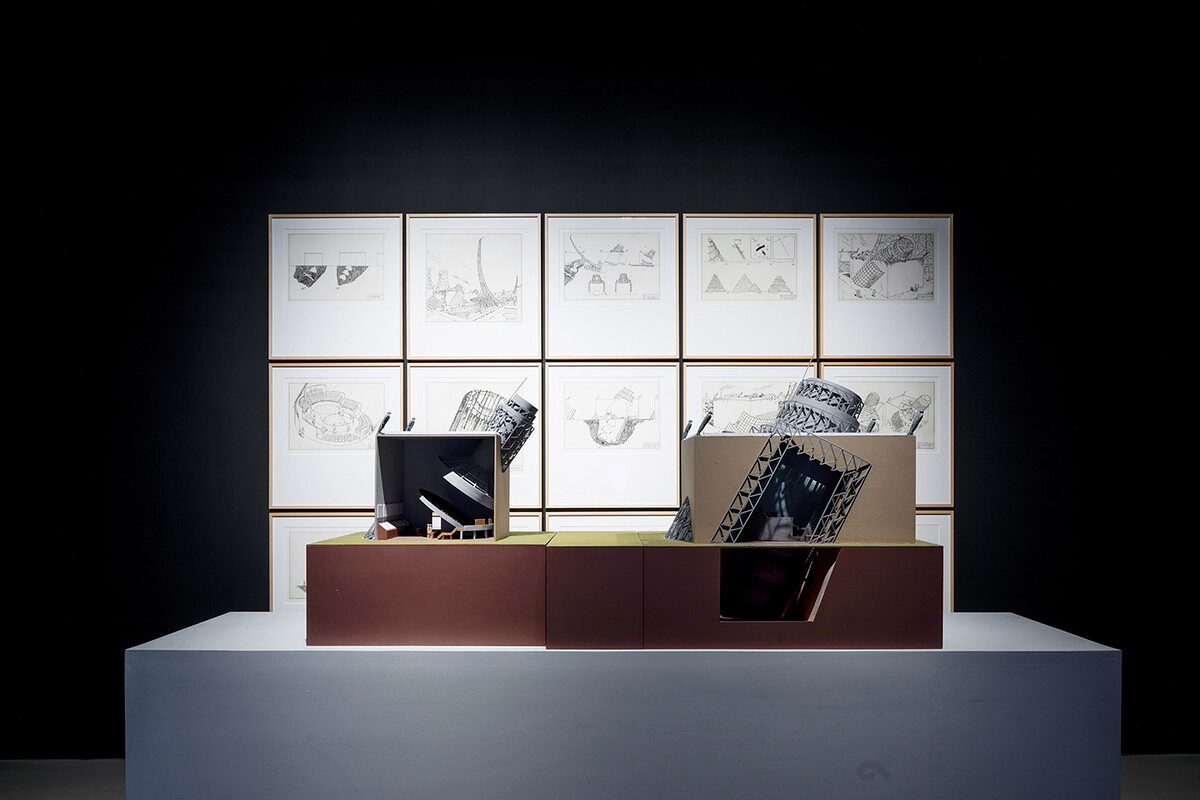We observe a dim corridor leading to the front of a house with a small extension, where illuminated windows suggest activity inside. The camera trembles as it focuses on a window, revealing a scene within. In the foreground, a kitchen table corner is adorned with a bowl of fruit, a glass, two books wrapped in plastic film, and chairs peeking from behind. In the background, a large house plant stands against a wooden wall with narrow, dark openings. Above, austere hemispherical lamps reminiscent of Soviet institutions cast a luminous glow. Seated at the table, facing the viewer, is the solitary figure of Ilya Iosifovich Kabakov, clad in a blue and white checkered shirt, his hand resting on the table, head bowed. His face remains obscured. The camera shakes, suggesting Kabakov may be lost in thought, asleep, or troubled. Suddenly, his voice off-screen startles us: “It’s completely obvious to me that I have this cosmic … craving for cosmism, cosmos.” This marks the commencement of the film Poor Folk: Kabakovs, a tribute to the life and artistry of Ilya and Emilia Kabakov.
Kabakov delves into his past, recounting solitary walks along the Black Sea coast in his youth, where he experienced profound cosmic revelations. One night, under the starlit sky, he felt a profound connection to the universe, perceiving a terrifying insignificance on Earth. This cosmic dread mirrors the essence of total installation, synonymous with the Kabakov name.
The duo’s installations are intricately linked to spatial experiences, mirroring celestial transformations. However, one installation stands out, The Man Who Flew into Space from His Apartment, unveiled in 1985. This installation portrays a communal apartment room sealed off by authorities, where a resident, using a makeshift contraption, escapes Soviet reality, seeking refuge in the heavens.
This confined living space, approximately two square meters, is visible through hastily assembled boards. Adorned with Soviet propaganda posters, the walls feature sketches of trajectories, a city model, and a flight path diagram. A folding bed, chairs with a board, and a rubber catapult fastened to the walls occupy the room’s center. Trash litters the floor, and a gaping hole in the ceiling hints at the resident’s escape. Adjacent is a vestibule in typical Soviet hues, housing neighbors’ texts and an account of the event.
Kabakov elucidates that the installation symbolizes a quest for paradise by a Soviet individual disillusioned with various ideologies. This parallels the ideologies of Russian cosmism’s pioneers, proposing cosmic resettlement and the conquest of space as inevitable endeavors. Despite initial setbacks, the pursuit of defying gravity persisted, inspiring subsequent achievements in space exploration.
The protagonist of Kabakov’s installation embodies the spirit of Soviet inventors, ingeniously striving for transcendence. His meticulous plan for departure involves harnessing cosmic energy to ascend to the heavens. Through a detailed project involving a catapult and precise calculations, he envisages a brief but transformative journey into the cosmic realm.
Kabakov’s narrative transcends mere escapism, reflecting his own journey from Soviet confines to the expanses of Western art. His pragmatic approach to adapting to new environments contrasts with his contemporaries’ struggles to shed past accolades. Embracing the challenges of a foreign art scene, the Kabakovs navigated linguistic and cultural barriers with finesse, a feat uncommon among Soviet emigres.
The Kabakovs’ innovative spirit is evident in their approach to art and life. Ilya’s childhood experiences in wartime Samarkand, where art became a tool for acceptance, parallel his later artistic endeavors challenging Soviet norms. His pragmatic stance, balancing official illustration work with underground conceptual ventures, exemplifies a nuanced response to societal constraints.
Transitioning to painting in the 2000s, Kabakov redefines his artistic expression, emphasizing the longevity of paintings compared to installations. This shift underscores his quest for posthumous recognition, symbolizing an unconscious yearning for immortality through artistic legacy. Despite the challenges of conserving installations, Kabakov finds solace in the enduring nature of painting, a medium he once deemed secondary yet now embraces as a vital form of expression.
Kabakov’s pursuit of immortality through art mirrors the audacious aspirations of his fictional character seeking cosmic liberation. This grandiose endeavor, akin to launching oneself into space from a humble abode, embodies a rational yet visionary approach to artistic legacy. Just as the protagonist’s catapult symbolizes a daring quest for transcendence, Kabakov’s artistic evolution signifies a relentless pursuit of artistic immortality.
